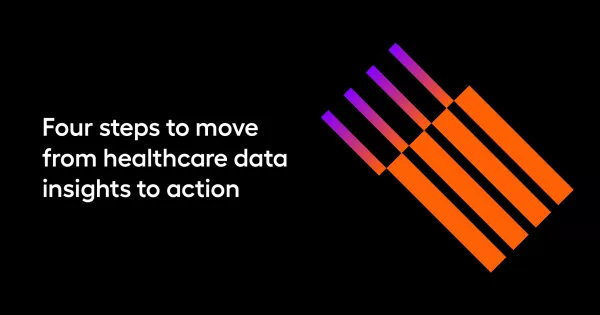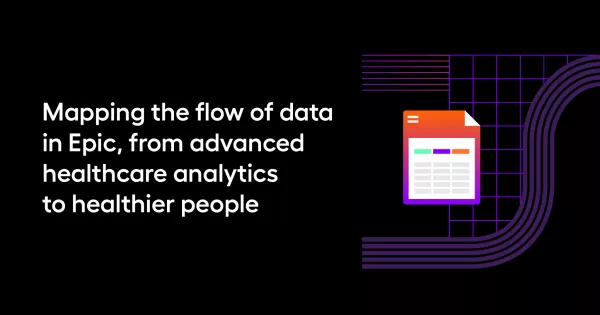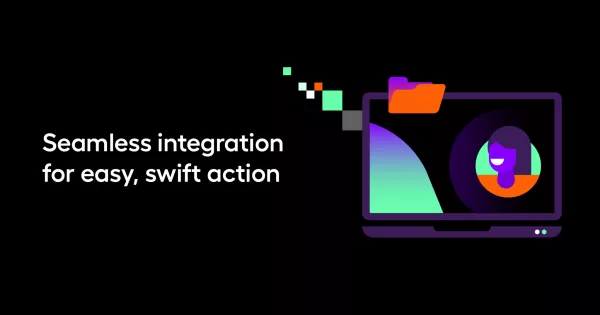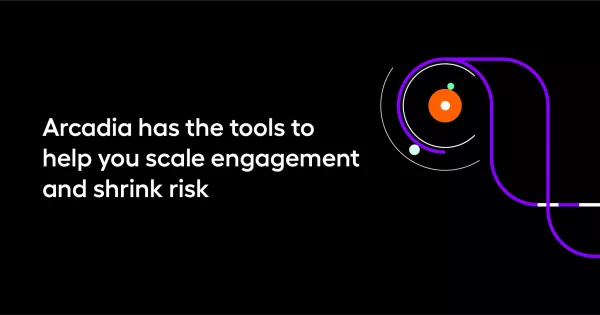From healthcare insights to action at the point of care
Use healthcare data analytics to improve lives, close risk, and measure success.
Predictive analytics and healthcare data are only useful if they draw meaningful conclusions. No one takes this to heart like Brendan Smith-Elion, Arcadia’s Vice President of Product Management. He’s spent years translating analytic insights into actionable steps, toggling between statistics and the human lives they impact.
But when the data unearths something remarkable — from a risk gap in need of closure to a potential diagnosis — moving from analysis to action can prove difficult. Here, Smith-Elion looks at Arcadia’s decades of experience in healthcare data and population health analytics to carve out a smoother path from discovery to implementation.

Four steps to move from healthcare data insights to action
How do you drive insights or opportunities that you’ve identified in the data to the point of care? Smith-Elion finds that four considerations are key.
#1: Let outcomes drive your work
Once you’ve got a meaningful pile of data, you need to drill into specifics. Definitions are everything in medical data analytics: define outcomes, metrics, and what you’re looking to change, whether it’s patient or provider behavior.
Specificity is key, and it will ground the work in a measurable way. Do you want 5% fewer emergency room visits? Do you want providers to administer a mental health screening for every new patient, detecting depression before it worsens? A clear sense of objectives and the ideal outcome of this work roots your efforts in reality and sets you up to succeed.
#2: Identify key stakeholders
Hone in on the stakeholders you want to involve. Is it providers? Payers? Patients? This will inform which data sources to tap, and the data you gather will be contingent on the personas involved. For payers, that might be insurance claims, but for patients, it could be a mix of numerous formats, like EHRs or lab results.
Additionally, it helps to think of these stakeholders as partners in implementation — getting insights from a computer screen to a screening room necessitates collaboration between everyone involved.
#3: Keep it complementary
Your efforts should be complementary, meeting the provider or patient where they are. This serves two purposes: it makes the changes you’re implementing work better, and it also increases buy-in from the stakeholders you rely on.
This means an honest reckoning with what kind of communication works best. Doctors may not read a lengthy message sent via app or portal. Can you communicate to them as they’re performing a certain behavior or making key decisions?
“Meet the provider where they are, and don’t just assume that they’re going to get a PDF and read it,” Smith-Elion says.
“If you’re giving them information about a diagnosis that you want them to consider, that should be in line with their normal documentation, normal workflows, and counter-diagnoses. It shouldn’t be in some other application, or some portal that they have to log into adding additional clicks, adding additional friction to the workflow.”
#4: Integrate, integrate, integrate
Any tools you’re bringing in should fit harmoniously with existing infrastructure. That means not radically upending a user interface or peppering confusing steps into a workflow that breaks down the system.
“If you’re bringing additional components in, it should not bring the provider out of the workflow. It has to be all engrained, in line,” Smith-Elion says. In short, you’re aiming for the smoothest, least noticeable intrusion.
In that vein, consider and address data quality issues before they arise. Try to anticipate problems and solve them before they have a chance to become disruptive. This is easiest with a flexible platform, and knowing any integration requirements ahead of time will stave off unpleasant surprises.

An Epic journey from insights to action
Arcadia’s integration with popular EMR software Epic illustrates how many steps and stakeholders it takes to transform a pile of data into a healthier population. The data is its own ecosystem: it flows in from the source (medical records), and then downstream from data analysts to administrators and practitioners, who add additional context and new information. The process is a constant cycle, a feedback loop that ideally grows smoother and more refined with use.

Mapping the flow of data in Epic, from advanced healthcare analytics to healthier people
First, Arcadia pulls the data from Epic’s electronic records into our proprietary system, so that we can discover opportunities in real-time. This means a plethora of data types — coded, uncoded, billing, scheduling — cleaned up and organized so they’re coherent and ready for analysis.
The discoveries and insights that are unearthed in this process then go straight to management staff at the healthcare systems that use this software. Administrators and practitioners can comb through these findings in Epic, then act on them as they see fit.
Beyond identifying trends, we’re pushing actionable workflows and diagnostic suggestions back to providers. Highly particular opportunities around diagnoses and rules are like needles in a haystack of information — a single person could take years to surface them, but Arcadia’s analytic software can draw these essential clues out swiftly. Critically, this is all happening within Epic, so no one’s relying on a provider checking multiple sources or scouring for these insights outside their usual processes.
Put simply, data helps form a hypothesis, data analysts and healthcare systems test that theory inside the platform, and then the results are recorded — data begets data, all of which gets us closer to population health and efficiency.

Seamless integration for easy, swift action
The Epic app illustrates Smith-Elion’s point about integration — users are already familiar with Epic, so Arcadia’s add-in fits easily into providers’ and administrators’ existing processes. Instead of putting demands on their time, suggested actions appear where their workflows already take place.
One of these tools is the counter-diagnosis workflow, which adds considerations and recommendations for providers as they’re assessing a patient’s symptoms. It isn’t aggressive or demanding — no pop-ups or windows — but it lists out additional options that might unlock a clinical answer.
The goal in the journey from insight to action is seamlessness — the fewer barriers, the less likely anyone trips up on clunky processes.

Pause, take stock, and reflect on healthcare data insights
The most important piece is evaluating success. If the data showed possibilities for improvement, did those come true? This is measurable within the Epic integration, and it creates a positive feedback loop — opportunity surfaces, it’s incorporated into the provider workflow, and then its efficacy is reported and slid back into Epic as additional data.
When data gets funneled back into the system (like reports on the success of a new workflow, or changes in the numbers of patients with similar symptoms), it’s formatted to FHIR standards, so as it’s inserted, it’s usable and referenceable in near-real-time.
Ultimately, turning insight into action at the point of care is a translation between hard, quantitative data and qualitative measures. Think of data like a rigid language, while metrics like risk and population health are a different dialect. Some words or sentences come through, but the challenge is creating coherent policy. Vital information has the potential to get lost, but in the end, success looks like a fluid, fluent conversation between these two measures of health.

Arcadia has the tools to help you scale engagement and shrink risk
The challenge is momentous — taking a vast pool of information and finding the meaning there. It’s daunting, but it’s the most important step a healthcare system can take. Data empowers you to make the leap from “how it’s always been done” to a path-breaking, optimized workflow that champions health and efficiency.
Start the conversation to learn more.
